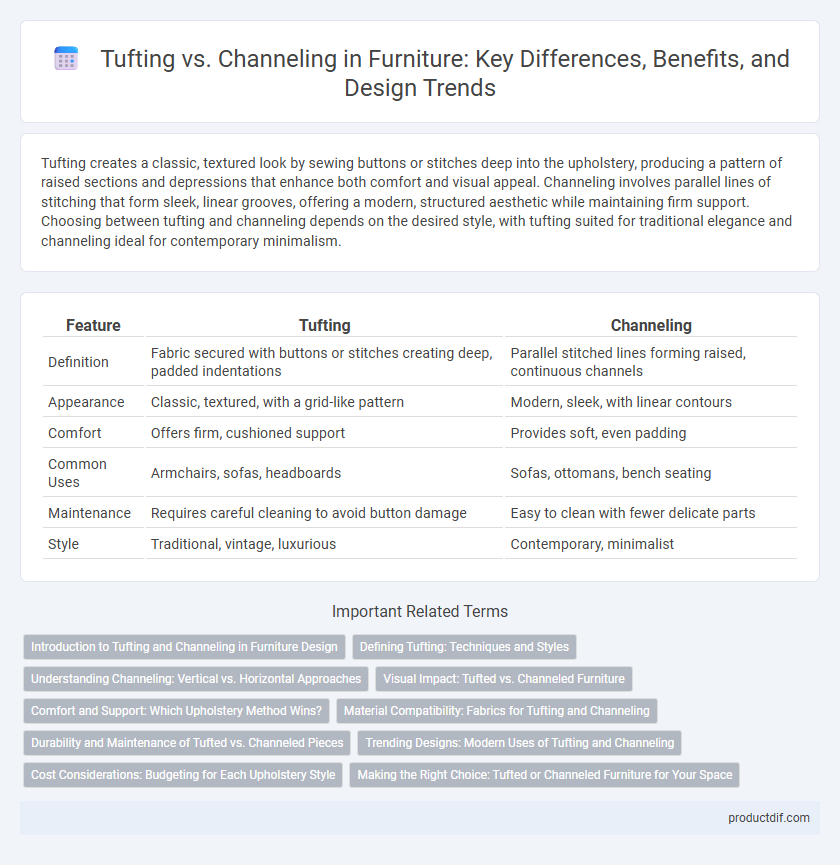Tufting creates a classic, textured look by sewing buttons or stitches deep into the upholstery, producing a pattern of raised sections and depressions that enhance both comfort and visual appeal. Channeling involves parallel lines of stitching that form sleek, linear grooves, offering a modern, structured aesthetic while maintaining firm support. Choosing between tufting and channeling depends on the desired style, with tufting suited for traditional elegance and channeling ideal for contemporary minimalism.
Table of Comparison
| Feature | Tufting | Channeling |
|---|---|---|
| Definition | Fabric secured with buttons or stitches creating deep, padded indentations | Parallel stitched lines forming raised, continuous channels |
| Appearance | Classic, textured, with a grid-like pattern | Modern, sleek, with linear contours |
| Comfort | Offers firm, cushioned support | Provides soft, even padding |
| Common Uses | Armchairs, sofas, headboards | Sofas, ottomans, bench seating |
| Maintenance | Requires careful cleaning to avoid button damage | Easy to clean with fewer delicate parts |
| Style | Traditional, vintage, luxurious | Contemporary, minimalist |
Introduction to Tufting and Channeling in Furniture Design
Tufting in furniture design involves sewing buttons or stitches through upholstery to create a textured, cushioned surface that enhances both comfort and style. Channeling features parallel lines of fabric or padding sewn into the upholstery, producing a sleek, linear pattern that emphasizes structure and modernity. Both techniques are popular in sofas, headboards, and chairs, offering distinct aesthetic and tactile qualities that influence the overall design impact.
Defining Tufting: Techniques and Styles
Tufting is a furniture upholstery technique where fabric is tightly pulled and secured with buttons or stitches, creating a series of indentations that add texture and visual interest. Popular styles include diamond tufting, which forms a geometric pattern, and button tufting, known for its classic and elegant appearance. This method enhances durability and comfort, making it ideal for sofas, headboards, and chairs.
Understanding Channeling: Vertical vs. Horizontal Approaches
Channeling in furniture upholstery features parallel lines or grooves that can be arranged either vertically or horizontally to enhance texture and aesthetic appeal. Vertical channeling creates an elongating effect, often used in headboards and sofas to add height and sophistication, while horizontal channeling emphasizes width and comfort, making it popular for cushions and bench seating. Selecting between vertical and horizontal channeling depends on the desired visual impact and functional use within a room's design scheme.
Visual Impact: Tufted vs. Channeled Furniture
Tufted furniture showcases a classic, textured pattern with deep buttoned indentations that create a luxurious and inviting appearance, making it a focal point in any room. Channeled furniture features parallel, vertical or horizontal stitched lines that offer a sleek, modern aesthetic with a clean and structured visual impact. Both tufting and channeling enhance upholstery designs, but tufting emphasizes depth and softness while channeling highlights streamlined sophistication.
Comfort and Support: Which Upholstery Method Wins?
Tufting offers deep, cushioned softness by securing padding with evenly spaced buttons, creating a plush surface that enhances comfort and provides firm support. Channeling features parallel stitched lines that offer a structured, ergonomic feel by distributing pressure evenly across the back, promoting better posture. For superior comfort and support, tufting excels in softness, while channeling leads in maintaining consistent spinal alignment.
Material Compatibility: Fabrics for Tufting and Channeling
Tufting is highly compatible with thick, durable fabrics such as velvet, leather, and heavy linen, which allow for deep, secure button pulls and a plush texture. Channeling suits both soft and medium-weight fabrics like cotton blends, velour, and faux suede, enabling smooth, defined linear patterns without puckering. Choosing the right fabric enhances the aesthetic and longevity of tufted or channeled furniture designs.
Durability and Maintenance of Tufted vs. Channeled Pieces
Tufted furniture features tightly sewn patterns that enhance durability by preventing fabric sagging and wear over time, while channeled pieces rely on sewn vertical or horizontal ridges that can collect dust and require more frequent cleaning. Tufting's dense stitching helps maintain structural integrity and resist deformation, making it a low-maintenance option ideal for high-use areas. Channeling, though stylish, demands careful upkeep to avoid dirt accumulation in the seams, potentially reducing its longevity compared to tufted designs.
Trending Designs: Modern Uses of Tufting and Channeling
Tufting and channeling are trending designs in modern furniture, with tufting offering a classic, textured look through stitched patterns that create deep buttoned or diamond shapes. Channeling emphasizes sleek, linear grooves running vertically or horizontally, providing a minimalist and structured aesthetic ideal for contemporary sofas and headboards. Both techniques enhance the tactile and visual appeal of upholstered pieces, making them popular choices in luxury living room and bedroom designs.
Cost Considerations: Budgeting for Each Upholstery Style
Tufting typically involves intricate hand-stitching techniques that increase labor costs, making it a more expensive upholstery option compared to channeling. Channeling uses vertical or horizontal fabric folds sewn directly into the furniture, requiring less labor and material, resulting in a more budget-friendly choice. When budgeting, consider that tufting's detailed craftsmanship adds to long-term value, while channeling offers a sleek look with cost efficiency.
Making the Right Choice: Tufted or Channeled Furniture for Your Space
Tufted furniture features button-tied or stitched upholstery that creates a textured, grid-like pattern, adding depth and classic elegance to sofas and chairs. Channeling utilizes vertical or horizontal stitched channels to produce a sleek, modern look with clean lines and enhanced comfort through cushioned support. Choosing between tufted and channeled furniture depends on your interior style preferences, desired texture, and the statement you want to make in your living space.
Tufting vs Channeling Infographic

 productdif.com
productdif.com